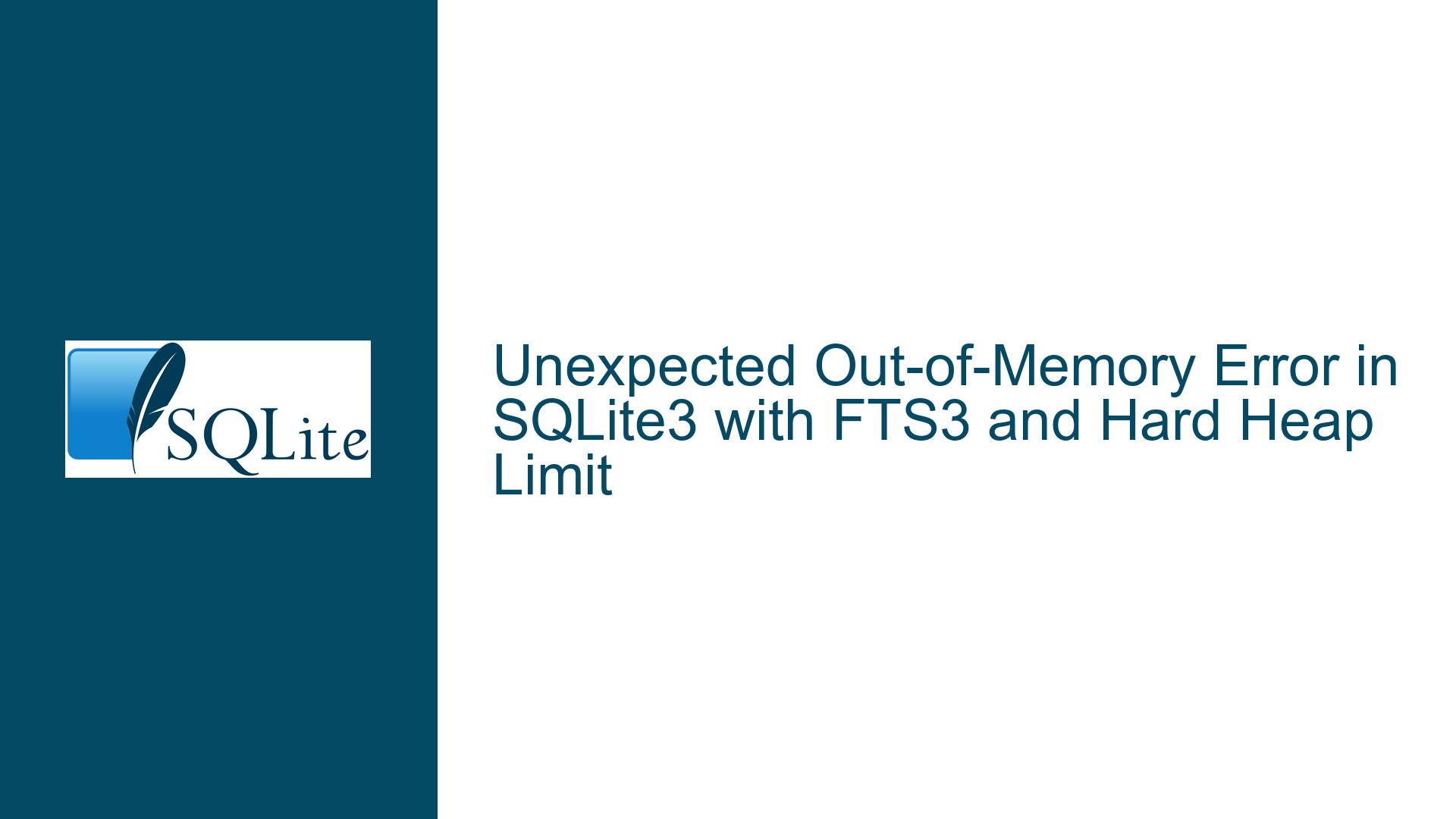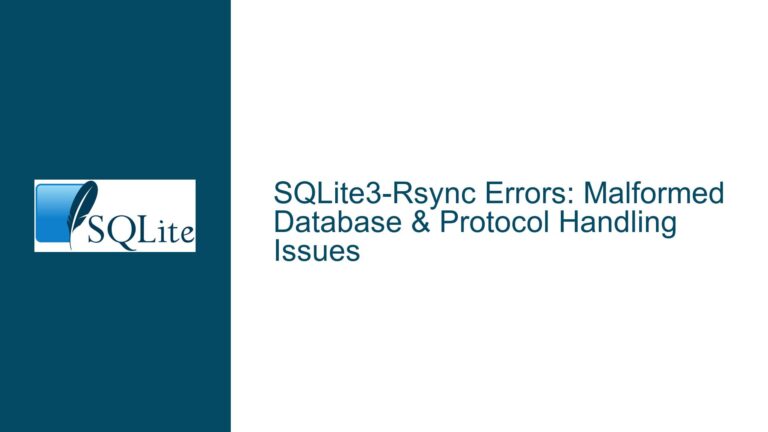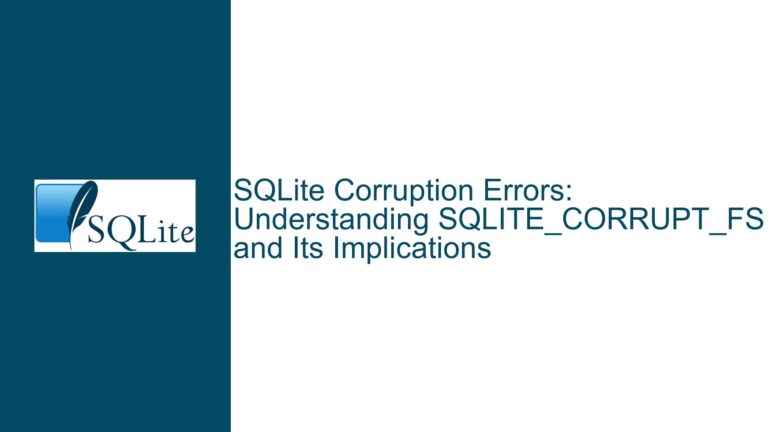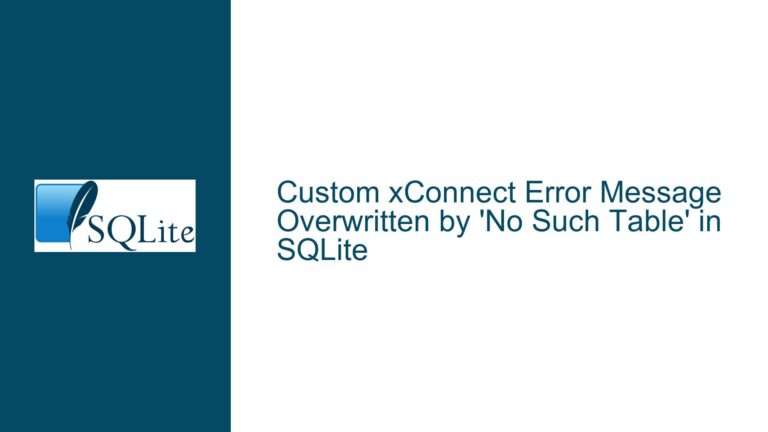Unexpected Out-of-Memory Error in SQLite3 with FTS3 and Hard Heap Limit
Issue Overview: SQLite3 Out-of-Memory Error with FTS3 and Specific Heap Limits
The core issue revolves around an unexpected out-of-memory (OOM) error in SQLite3 when executing a sequence of SQL statements involving a virtual table created using the Full-Text Search version 3 (FTS3) module. The error occurs under specific conditions related to the hard_heap_limit pragma, which restricts the maximum amount of heap memory SQLite can allocate. The problem manifests when the hard_heap_limit is set within a narrow range (e.g., between 188,265 and 192,608 bytes on the original poster’s machine). Outside this range, the query executes without issues.
The sequence of operations that triggers the error is as follows:
- A savepoint is created using
SAVEPOINT one;. - The
hard_heap_limitis set to a value within the problematic range (e.g., 191,000 bytes). - A virtual table
t1is created using the FTS3 module with a single columna. - A simple
SELECTquery ont1executes successfully. - Two subsequent statements,
PRAGMA integrity_check A;andSELECT t2;, are executed. Both statements contain syntax errors and fail to execute, but they alter SQLite’s internal state. - A second
SELECTquery ont1results in an out-of-memory error. - A third
SELECTquery ont1fails with an error indicating that the tablet1no longer exists.
The issue is particularly puzzling because:
- The error only occurs within a specific range of
hard_heap_limitvalues. Setting the limit below or above this range avoids the problem. - The presence of syntax errors in the
PRAGMA integrity_check A;andSELECT t2;statements appears to influence SQLite’s internal state, leading to the OOM error and subsequent table disappearance. - Replacing FTS3 with FTS4 or inserting data into the virtual table
t1prevents the issue from occurring.
This behavior suggests a potential bug or edge case in SQLite’s memory management or virtual table handling, particularly when operating under constrained memory conditions.
Possible Causes: Memory Management and Virtual Table Interactions
The issue appears to stem from a combination of factors related to SQLite’s memory management and its handling of virtual tables, particularly those created using the FTS3 module. Below are the key factors that likely contribute to the problem:
1. Heap Limit Constraints and Memory Fragmentation
The hard_heap_limit pragma restricts the total amount of heap memory SQLite can allocate. When the limit is set within a specific range, SQLite may allocate memory in a way that leads to fragmentation or inefficient use of available memory. This can result in situations where SQLite is unable to allocate additional memory for subsequent operations, even though the total available memory should theoretically be sufficient.
The fact that the issue only occurs within a narrow range of hard_heap_limit values suggests that SQLite’s memory allocation strategy changes behavior at certain thresholds. For example, SQLite might switch between different memory management algorithms or data structures based on the available heap size, leading to unexpected behavior when operating near these thresholds.
2. Impact of Syntax Errors on Internal State
The presence of syntax errors in the PRAGMA integrity_check A; and SELECT t2; statements appears to influence SQLite’s internal state. While these statements fail to execute due to their syntax errors, they may still trigger internal operations that consume memory or alter SQLite’s state in unexpected ways.
For example, the PRAGMA integrity_check statement typically performs a consistency check on the database. Even though the statement contains a syntax error, SQLite might still attempt to initialize resources or allocate memory for the operation, which could contribute to the subsequent OOM error.
3. FTS3 Virtual Table Behavior
The FTS3 module, used to create the virtual table t1, has specific memory requirements and behaviors that differ from regular tables. Virtual tables in SQLite often rely on custom implementations for storage, indexing, and query execution, which can introduce additional complexity and memory usage.
The fact that replacing FTS3 with FTS4 or inserting data into the virtual table eliminates the issue suggests that FTS3’s memory management or initialization process is particularly sensitive to heap limit constraints. FTS4, being a more advanced version of the module, may handle memory allocation more efficiently or use different internal structures that avoid the problem.
4. Memory Manager Overhead
As noted in the discussion, memory managers (e.g., malloc in glibc) often use additional memory for management purposes, such as maintaining metadata, linked lists, or other structures. The amount of overhead can vary depending on the total amount of memory allocated. When the hard_heap_limit is set within a specific range, the memory manager might allocate more overhead, reducing the amount of memory available for SQLite’s operations and triggering an OOM error.
This behavior could explain why the issue occurs only within a specific range of hard_heap_limit values. At lower limits, the memory manager might use a simpler, more efficient strategy with less overhead. At higher limits, the overhead might be a smaller proportion of the total memory, leaving enough space for SQLite’s operations.
Troubleshooting Steps, Solutions & Fixes: Addressing the Out-of-Memory Error
To address the out-of-memory error and its underlying causes, consider the following steps and solutions:
1. Adjust the Heap Limit
Since the issue occurs only within a specific range of hard_heap_limit values, one straightforward solution is to avoid setting the limit within this range. If your application requires a constrained heap size, experiment with different values to identify a safe range that avoids the problem.
For example, if the problematic range is between 188,265 and 192,608 bytes, consider setting the limit below 188,265 or above 192,608. Use a script to test different values, as demonstrated in the discussion, to identify the optimal limit for your environment.
2. Upgrade to FTS4 or FTS5
The issue appears to be specific to the FTS3 module. Upgrading to FTS4 or FTS5, which are more advanced and efficient versions of the Full-Text Search module, can help avoid the problem. These modules may handle memory allocation and virtual table operations more robustly, reducing the likelihood of OOM errors.
To upgrade, modify the CREATE VIRTUAL TABLE statement to use fts4 or fts5 instead of fts3:
CREATE VIRTUAL TABLE t1 USING fts4 ( a );
or
CREATE VIRTUAL TABLE t1 USING fts5 ( a );
3. Insert Data into the Virtual Table
The issue does not occur when data is inserted into the virtual table t1. This suggests that the presence of data alters the memory usage or initialization process in a way that avoids the problem. If your application allows it, consider inserting a small amount of data into the virtual table after creation:
INSERT INTO t1 (a) VALUES ('sample data');
4. Review and Optimize SQL Statements
Ensure that all SQL statements are syntactically correct and do not contain errors. Syntax errors, such as those in PRAGMA integrity_check A; and SELECT t2;, can have unintended side effects on SQLite’s internal state. Review your queries and fix any syntax issues to avoid triggering unexpected behavior.
5. Monitor and Debug Memory Usage
Use SQLite’s built-in tools and pragmas to monitor memory usage and identify potential bottlenecks. For example, the PRAGMA memory_status; command provides information about SQLite’s current memory usage, including the number of allocations and the total amount of memory allocated.
Additionally, consider enabling SQLite’s debugging features or using a debug build to gain more insight into memory allocation patterns and identify the root cause of the OOM error.
6. Consider Alternative Memory Managers
If the issue is related to the memory manager’s overhead, consider using an alternative memory manager or custom allocator with SQLite. SQLite allows you to replace its default memory allocator with a custom implementation, which might provide better performance or more predictable behavior under constrained memory conditions.
7. Report the Issue to SQLite Developers
If the issue persists and cannot be resolved through the above steps, consider reporting it to the SQLite development team. Provide a detailed description of the problem, including the exact sequence of SQL statements, the hard_heap_limit range, and any relevant environment details. This will help the developers investigate the issue and potentially address it in a future release.
By following these troubleshooting steps and solutions, you can address the out-of-memory error and ensure stable operation of SQLite under constrained memory conditions.






